![]()
![]()
![]()
Use LEFT and RIGHT arrow keys to navigate between flashcards;
Use UP and DOWN arrow keys to flip the card;
H to show hint;
A reads text to speech;
22 Cards in this Set
- Front
- Back
|
The working memory model |
The multi store model as well as other memory models could not account for some of the findings form a memory research, especially the STM Baddeley and Hitch referred to the case of KF who had a digit span of 2 but could transfer new information to the LTM the |
|
|
The working memory model |
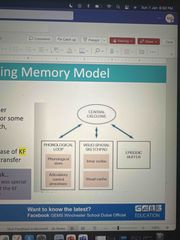
Back (Definition) |
|
|
KEY study- WMM- Baddeley and Hitch Aim |
Aim- to investigate the complex yet flexible STM |
|
|
Key stud- WMM- Baddeley and Hitch Method |
Method- presented the participants with a 6 digit number to say over and over again. Simultaneously, they were presented a series of sentences such as A follows B - AB and were asked to press a button for true or false. He reason that if STM has only 5-9 items capacity, participants would show impaired performance as they would be completely occupied with the verbal task |
|
|
Key stud- WMM- Baddeley and Hitch Result |
Result- they took a little longer to verify but overall they made very few Erie’s on both the reasoning or the digit span task |
|
|
Key stud- WMM- Baddeley and Hitch Conclusion |
Conclusion- STM must have more than one component and works like a space were variety of operations can be carried out on both old and new memory |
|
|
The central executive system |
It is part of the Working memory that coordinates with the other components, ie it is a supervisory component • has limited capacity •can process information from any sensory system This is supported by “slave systems” ie a temporary storage so it frees up space to deal with more demanding information processing tasks. They are separate systems with own responsibilities. They are • the phonological loop •Visio- spatial sketch pad • episodic buffer |
|
|
The phonological loop |
It is referred as the inner voice. It deals with auditory information. Limited capacity, temporary and holds information in a speech based form Contains 2 stores • phonological store- passive •articulatory control process- active |
|
|
The phonological loop- Baddeley Experiment Method |
Method- participants were given visual representations of 5 word lists for very brief exposures and they were to write in the same order as presented Condition 1- harm, wit, twice (single syllable words) Condition 2- organization, university, association (polysyllabic words) |
|
|
The phonological loop- Baddeley Experiment Result |
Result- average correct recall showed marked superiority for short words and termed it the “word length effect” |
|
|
The phonological loop- Baddeley Experiment Conclusion |
Conclusion- Phonological loop capacity is determined by the length of time to say the words than number of items (5-9). They estimated this time as 1.5 sec |
|
|
The Visuo- spatial sketchpac |
It is referred to as the inner eye. It deals with visual information Limited capacity (3-4 items), temporary and holds information for holding visual and spatial information Contains 2 stores • visual cache- passive •inner scribe - active |
|
|
The Visuo Spatial sketch pad researched- klauer and Zhao 2004 Method |
Method- participants did 2 tasks- •visual task - chinese ideographs •spatial task- memory locations of dots on a screen While doing one of the tasks they were required to do either a spatial or visual interference task. There was no control group |
|
|
The Visuo Spatial sketch pad researched- klauer and Zhao 2004 Result |
Result- spatial tasks were more disturbed by spatial interference task and vice versa |
|
|
The Visuo Spatial sketch pad researched- klauer and Zhao 2004 Conclusion |
Conclusion- this was evidence for the existence of visual and spatial components |
|
|
Episodic buffer |
Provides a general storage facility, holding and combining information from all the three components as well as the LTM relatively new component that was introduced 25 years prior and hence limited research |
|
|
Episodic buffer research- Baddeley 2000 |
Immediate memory for prose is generally much greater than that of unrelated words. WMM could not explain this as one must know what the words mean, their relation in sentences, sentence structure, this type of analysis requires LTM |
|
|
WMM- strengths and weaknesses |
• it has been extremely influential. The term WMM is preferred over STM. A) explains the store in terms of both a temporary storage and active processing B) the rehearsal loop is seen as just an optional process than the sole way to transfer information from the STM to LTM •WMM attempts to explain how memory functions Baddeley et al 1998- presented evidence thay the phonological loop plays a key role in the development of reading. It was found that it does not function properly in some children with dyslexia. This shows it plays a crucial role in: A) helping to comprehend complex text B) helps in learning of new spoken vocabulary •accounts for individual differences |
|
|
Central executive |
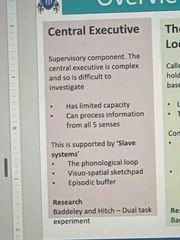
Back (Definition) |
|
|
The phonological loop |
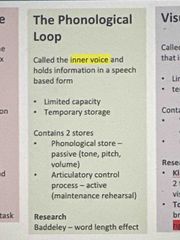
Back (Definition) |
|
|
Visual spatial Sketchpad |
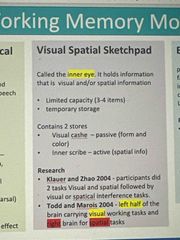
Back (Definition) |
|
|
Episodic Buffer |
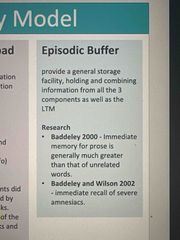
Back (Definition) |

